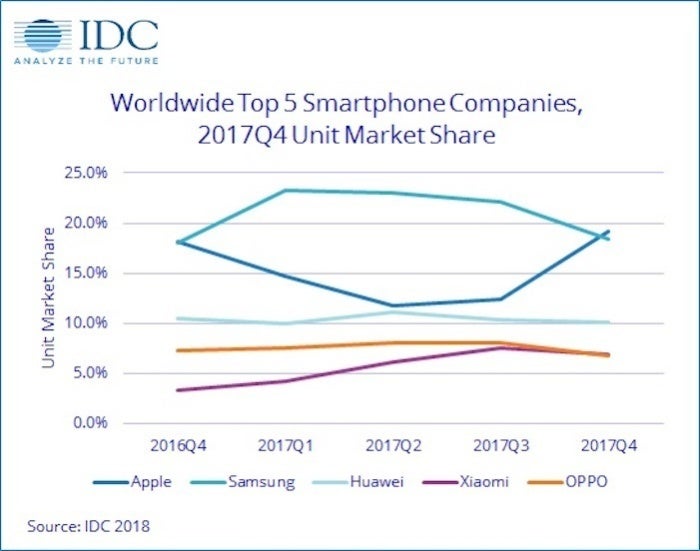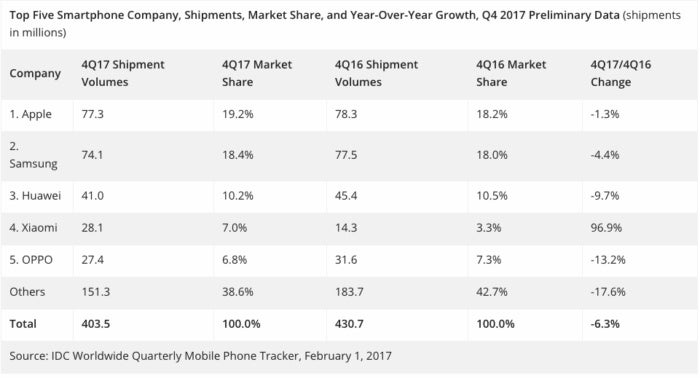iPhone 8 and X propel Apple into smartphone lead over Samsung
Apple has surpassed Samsung as the world's leading shipper of smartphones, according to two industry reports released today.
Though IDC and IHS Markit had differing numbers for the fourth quarter of 2017, the result was the same: Apple handsets surpassed Samsung in shipments for only the second time in history.
"The new models from Apple played a key role in moving Apple ahead of Samsung in Q4," said Ryan Reith, vice president for IDC's Mobile Device Tracker report.
According to Apple's own numbers, it's selling about 10 iPhone per second -- most of which are iPhone X's.
Apple yesterday announced quarterly revenue of $88.3 billion, an increase of 13% year-over-year -- an all-time record. International sales accounted for 65 percent of the quarter’s revenue.
Apple once before surpassed Samsung in handset shipments – in the fourth quarter of 2016. But that was considered an anomaly by analysts at the time.
"Apple had a good holiday quarter [in 2016], but it was also the same time Samsung was going through that whole issue with the Note 7 and the battery issue. So Samsung was having its own issues, while Apple was doing well," Reith said. "There was no anomaly this quarter. There's no question [Apple is] gaining traction."
Apple shipments, Reith said, are driven by holiday sales because their new product release cycle comes just prior to that season.
 IDC
IDC"There's a good chance they could see a soft first half of 2018. That's not because they're doing anything wrong," Reith said. "That's mainly because of the way the fan base follows their new product. They rush out to buy the new product and then it sort of tapers off a little bit as you get closer to the September announcement for new products."
Smartphone shipments flatten
While Apple may have passed Samsung, overall smartphone shipments declined 6.3% in the fourth quarter of 2017, and shipments for the whole year decreased just under 1% due to higher-priced "ultra-high-end flagship" models, IDC said.
IHS Markit research saw the market slightly different, with shipments dipping a bit less (4.5%) from Q3 to Q4 while increasing 3.5% for the year.
Leading the market in the fourth quarter, Apple shipped 77.3 million smartphones, 1.2% fewer than in 2016, according to IHS. Samsung shipped 74.3 million units, down 2.2%.
Apple accounted for 20% of all smartphones shipped in the fourth quarter. Samsung followed at 19%, according to IHS.
IDC also pegged Apple's shipments at 77.3 million in Q4, but it saw that as a 1.3% decrease year-over-year.
Although demand for the new higher priced iPhone X may not have been as strong as many expected, the overall iPhone lineup appealed to a wider range of consumers in both emerging and developed markets, IDC said. Apple finished second for the full year in 2017 shipping 215.8 million units, up 0.2% from the 215.4 million units shipped in 2016.
"Apple continues to prove that having numerous models at various price points bodes well for bringing smartphone owners to iOS," IDC said.
 IDC
IDCDeveloped markets, however, such as the U.S. and China both saw a decline during the quarter as "consumers appeared to be in no rush to upgrade to the newest generation of higher-priced flagship devices," IDC's research stated.
Even with new features, such as bezel-less, full-screen displays, advanced biometrics, and improved artificial intelligence, high price points may be outweighing the benefits of owning the "latest and greatest device in hand," said Anthony Scarsella, research manager for Mobile Phones at IDC.
"The latest flock of posh flagships may have had consumers hitting the pause button in the holiday quarter," Scarsella said. "With ultra-high-end flagships all the rage in 2017, many of these new bezel-less wonders proved to be more of a luxury than a necessity among upgraders."
Enterprise uptake of ultra-high-end smartphones
In terms of enterprise adoption, Apple has likely hit a ceiling with the high prices of its latest models, according to Reith.
"If Apple and to some extent Samsung and a few others continue to push the price of these devices up, it will be interesting to see how IT buyers react to that," Reith said. "I don't think they want to chase products that were $700 two years ago and are now $1,000 and [may go] up into the $1,200 range.
 IDC
IDC"They have to ask themselves, 'When does this stop?'" Reith continued. "I do think enterprises likely have hit a threshold in terms of what they'll actually put up in terms of their own budget. There are still a good number of offerings from both of those vendors at a cheaper price point."
Samsung, for example, has a product portfolio that consists of 80 to 100 smartphone SKUs at any given time, most of which are sub-$300, sub-$400 devices that aim for middle of the market or developing markets, Reith said.
Gerrit Schneemann, a senior analyst for Mobile Devices at IHS Markit, said when it comes to the enterprise market, iOS deployments would not typically rely on ultra-high-end devices, so "the cross-generational software support is still a key differentiator."
"I don't have any clear indication how iPhone X is being received by corporations," Schneemann said. "However, there aren't any features that are not available on other iPhones as well – the only significant change is animoji, [the facial recognition] and the new gesture-based interface. Beyond those two items, the experience and feature set on iPhone 7, for example, and iPhone 8 or X will be the same."
Smartphone face ID is also available on Android handsets, so Apple could easily implement a similar feature for other devices with Touch ID, Schneemann noted.
Over the past three years, enterprise purchasing of smartphones has remained relatively flat: about 6% of overall shipments, according to Reith, who attributed that to the popularity of bring-your-own-device (BYOD) corporate strategies that have plateaued.
Companies have mostly settled on offering employees two OS options: iOS or Android. "So, Apple is always in the equation. The real question is will the Android choice be Samsung or Huawei," Reith said, referring to the first and second best-selling Android handsets.

Post a Comment